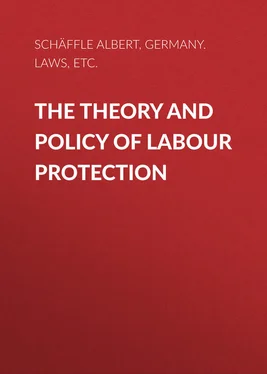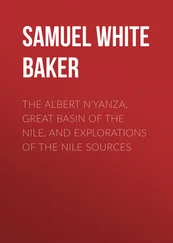Albert Schäffle - The Theory and Policy of Labour Protection
Здесь есть возможность читать онлайн «Albert Schäffle - The Theory and Policy of Labour Protection» — ознакомительный отрывок электронной книги совершенно бесплатно, а после прочтения отрывка купить полную версию. В некоторых случаях можно слушать аудио, скачать через торрент в формате fb2 и присутствует краткое содержание. Жанр: Юриспруденция, Юриспруденция, foreign_antique, foreign_prose, на английском языке. Описание произведения, (предисловие) а так же отзывы посетителей доступны на портале библиотеки ЛибКат.
- Название:The Theory and Policy of Labour Protection
- Автор:
- Жанр:
- Год:неизвестен
- ISBN:нет данных
- Рейтинг книги:5 / 5. Голосов: 1
-
Избранное:Добавить в избранное
- Отзывы:
-
Ваша оценка:
- 100
- 1
- 2
- 3
- 4
- 5
The Theory and Policy of Labour Protection: краткое содержание, описание и аннотация
Предлагаем к чтению аннотацию, описание, краткое содержание или предисловие (зависит от того, что написал сам автор книги «The Theory and Policy of Labour Protection»). Если вы не нашли необходимую информацию о книге — напишите в комментариях, мы постараемся отыскать её.
The Theory and Policy of Labour Protection — читать онлайн ознакомительный отрывок
Ниже представлен текст книги, разбитый по страницам. Система сохранения места последней прочитанной страницы, позволяет с удобством читать онлайн бесплатно книгу «The Theory and Policy of Labour Protection», без необходимости каждый раз заново искать на чём Вы остановились. Поставьте закладку, и сможете в любой момент перейти на страницу, на которой закончили чтение.
Интервал:
Закладка:
The superior limit of age of juvenile labour in factories is fixed at 14 years in southern countries (in those represented at the Berlin Conference); at 16 years in Germany, Austria, and France (in connection with the fixing of the maximum duration of labour); and at 18 in Great Britain, Switzerland, and Denmark, and probably soon in France. With respect to night work and dangerous work, the superior limit (especially for women) is placed still higher (21 years), wherever such work is not entirely prohibited.
All wage-workers between the inferior and superior limits of age at which employment is permitted, are called, as already stated, “juvenile workers.” In many countries a further division of juvenile labour is made, into children and “young persons.” In Germany, Austria, Sweden, and Denmark – and in future probably in all those countries represented at the Berlin Conference – this division falls at the age of 14, and in southern countries at the age of 12 years. “Children,” in the meaning attached to the word by labour-protective legislation, are children of 12 to 14 years (in Germany in future 13 to 14, in Great Britain hitherto 10 to 14); “young persons” are juvenile workers from 14 to 16 years, in England of 14 to 18 years. In Switzerland juvenile workers are “young persons” of 14 to 18 years, as none under the age of 14 are employed at all.
Male labour and female labour. Women for the purposes of Labour Protection include all female workers enjoying special or extended protection, not only on account of youth, but also from considerations arising out of their sex and family duties. It is important that we should be clear on this point, in view of the demand now made for careful restriction of the employment of married women in factories, – either for the entire duration of married life or until the youngest child has reached the age of 14, – for the entire prohibition of night labour for women, and of the employment of women in certain trades during the periods of lying-in and of pregnancy.
Just as female labour for our purpose does not mean the labour of all female persons, so male labour does not include all labour of male persons, but only of such male persons as have protection on grounds other than that of youth. Hitherto, male labour has only had practically a negative meaning in protective law, it has been used in the sense of the unprotected labour of adult men. The demand for a maximum working day for all male labourers – at least in factories – and the concession of this demand have given a positive signification to the term male labour, as affected by protective legislation.
In considering the careful determination of the meaning of factory labour, workshop labour, household industry and family labour on the one hand, and child labour and female labour on the other hand, we cannot be too careful in guarding against undue limitations of the idea of Labour Protection. There are many who still take it to mean merely factory-protection, and indeed only factory-protection of “young persons.”
Labour Protection means something more than protection of industrial labour, in that it also deals with labour in mining and trading industry, and it must be extended still further to meet existing needs for protection.
Neither is industrial Labour Protection factory protection alone, nor even factory and quasi-factory protection alone, but beyond that it is also workshop protection, and, especially in its latest developments, protection of household industry, and perhaps even more or less of family industry; industrial home-work especially, from the Erz-Gebirge in Saxony, to the London sweating dens, admits of and actually suffers, from an amount of oppression which calls for special Labour Protection. We call attention to these facts in order to clear away certain still widespread misconceptions before we enter upon the classification of labour with respect to protective legislation. Particulars will be given in Chapters IV. to VIII.
CHAPTER III.
SURVEY OF THE EXISTING CONDITIONS OF LABOUR PROTECTION
In the first chapter we learnt to recognise the special character of Labour Protection in the strict sense of the term. We must further learn what is its actual aim and scope.
Labour Protection strictly so called, represents presumably the sum total of all those special measures of protection, which exist side by side with free self-help and mutual help, and with the ordinary state protection extended to all citizens, and to labourers among the rest. And such it really proves to be on examination of the present conditions and already observable tendencies of Labour Protection.
We shall only arrive at a clear and exhaustive theory and policy of Labour Protection both as a whole and in detail by examining separately and collectively all the phenomena of Labour Protection.
This will necessitate in the first place a comprehensive survey of the existing conditions of Labour Protection, and to this end a regular arrangement of the different forms which it takes.
In sketching such a survey we have to make a threefold division of the subject; first, the scope of Labour Protection, in the strict sense of the term; secondly, the various legislative methods of Labour Protection; and thirdly, the organisation of Labour Protection (as regards courts of administration, and their methods and course of procedure). In considering the scope of Labour Protection we have to examine the special measures adopted to meet the several dangers to which industrial wage-labour is exposed.
The following survey shows the actual field of labour protective legislation, as well as the wider extension which it is sought to give thereto.
A. Protection against material dangers.
1. Protection of employment; and this of two kinds, viz.: —
(i.) Restriction of employment;
(ii.) Prohibition of employment.
a. Protection of working-time with regard to the maximum duration of labour:
General maximum working-day.
Factory maximum working-day (unrestricted in the case of adults – restricted in the case of “juvenile workers” and women).
b. Protection of intervals of rest:
Protection of daily intervals – of night-work – of holidays – Sundays and festivals.
2. Protection during work:
Against dangers to life, health, and morals, and against neglect of teaching and instruction, incurred in course of work.
3. Protection in personal intercourse: —
In the personal and industrial relations existing between the dependent worker and the employer and his people (truck-protection).
B. Protection of the status of the workman (protection in the making and fulfilment of agreements) which may also be called:
Protection of agreement, or contract-protection.
1. Protection on entering into agreements of service, and throughout the duration of the contract:
Protection in terms of agreement and dismissal,
Protection against loss of character.
2. Regulation of admissible conditions of contract, and of legal extensions of contract.
3. Protection in the fulfilment of conditions after the completion of service agreements.
Compulsory legal protection – protection by the optional adoption of regulations.
Regulation under the code – regulation by special enactment.
1. Courts by which it is administered:
A. Protection by the ordinary administrative bodies —
Police,
Magistrates,
Church and School authorities,
Military and Naval authorities.
Читать дальшеИнтервал:
Закладка:
Похожие книги на «The Theory and Policy of Labour Protection»
Представляем Вашему вниманию похожие книги на «The Theory and Policy of Labour Protection» списком для выбора. Мы отобрали схожую по названию и смыслу литературу в надежде предоставить читателям больше вариантов отыскать новые, интересные, ещё непрочитанные произведения.
Обсуждение, отзывы о книге «The Theory and Policy of Labour Protection» и просто собственные мнения читателей. Оставьте ваши комментарии, напишите, что Вы думаете о произведении, его смысле или главных героях. Укажите что конкретно понравилось, а что нет, и почему Вы так считаете.












![Edward Ellis - Adrift on the Pacific - A Boys [sic] Story of the Sea and its Perils](/books/753342/edward-ellis-adrift-on-the-pacific-a-boys-sic-s-thumb.webp)